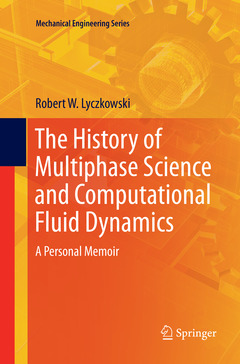Description
The History of Multiphase Science and Computational Fluid Dynamics, 1st ed. 2018
A Personal Memoir
Mechanical Engineering Series
Author: Lyczkowski Robert W.
Language: English
Subject for The History of Multiphase Science and Computational...:
121.31 €
In Print (Delivery period: 15 days).
Add to cartPublication date: 08-2018
Support: Print on demand
158.24 €
In Print (Delivery period: 15 days).
Add to cartPublication date: 10-2017
Support: Print on demand
Description
/li>Contents
/li>Biography
/li>Comment
/li>
This book tells the story of how the science of computational multiphase flow began in an effort to better analyze hypothetical light water power reactor accidents, including the ?loss of coolant? accident. Written in the style of a memoir by an author with 40 years? engineering research experience in computer modeling of fluidized beds and slurries, multiphase computational fluid dynamics, and multiphase flow, most recently at Argonne National Laboratory, the book traces how this new science developed during this time into RELAP5 and other computer programs to encompass realistic descriptions of phenomena ranging from fluidized beds for energy and chemicals production, slurry transport, pyroclastic flow from volcanoes, hemodynamics of blood-borne cells, and flow of granular particulates. Such descriptions are not possible using the classical single-phase Navier-Stokes equations. Whereas many books on computational techniques and computational fluid dynamics have appeared, they do not trace the historical development of the science in any detail, and none touch on the beginnings of multiphase science. A robust, process-rich account of technologic evolution, the book is ideal for students and practitioners of mechanical, chemical, nuclear engineering, and the history of science and technology.
1. Introduction.- 2. Cleveland State University, Cleveland 1959 – 1964.- 3.Illinois Institute of Technology (IIT), Chicago 1964 – 1970 .- 4. The Seeds are sown by Larry Ybarrondo in a stet far away, Idaho Falls, Idaho .- 5. Project Development begins.- 6. Characteristics analysis of the one-dimensional, two-fluid partial differential equations (PDEs) developed by Chuck Solbrig and Dan Hughes.- 7. The SLOOP code development.- 8 The Characteristics Paper Caper.- 9. RETRAN is Initiated at Energy Incorporated for EPRI hiring the core SLOOP code .- 10. RELAP5 is initiated by Victor Ransom and Dick Wagner funded by Ybarrondo.- 11. USDOE Starts Code Development at S Cubed and Jaycor to Address the Energy Crisis Caused by the Oil Embargos.- 12. Reactor Safety research Group breaks from T-3 Division.- 13. IIT code begins Using Los Alamos’ K-FIX Code.- 14. METC starts MFIX Code development using FLUFIX Code.- 15. FLUENT Code Debuts at Creare, Inc. and CFX .- 16. COMMIX Code Development at Argonne National Laboratory.- 17. International Conferences and Workshops addressing Multiphase needs and Problems begin .- 18. DOE OIT Center for Multiphase Dynamics Effort begins becomes the MDFRC.- 19. Gidaspow publishes First Book “Multiphase Flow and Fluidization Continuum and Kinetic Theory Descriptions”.- 20. NETL initiates Workshops on Multiphase Flow Research later called Multiphase Flow Science.- 21. The NETL Multiphase Flow Research “Roadmap” Document and its Critique.- 22. Gidaspow publishes Second Book “Computational Techniques: The Multiphase CFD Approach and Green Energy Technologies”.- 23. Conclusion - What Does the Future Hold?.
Robert W. Lyczkowski received his BChE in from Cleveland State University, Fenn School of Engineering and MS in Gas Engineering and PhD in Gas Technology from Illinois Institute of Technology. He worked for Lawrence Livermore National Laboratory, Idaho National Engineering Laboratory, Energy Incorporated, Goodyear Atomic Corp., Hooker Chemical Corp., and as a faculty member at Illinois Institute of Technology. He has been involved for over forty years in chemical and nuclear engineering applications of his multiphase theory and computational fluid dynamics expertise especially in the areas of heat transfer and energy conversion to develop models that are now used by industry world-wide to design various two-phase flow equipment. He is a Fellow of the American Institute of Chemical Engineers and a recipient of the prestigious Ernst W. Thiele Award.
Most of Dr. Lyczkowski’s career was spent as a Chemical Engineer in the Energy Systems Division at Argonne National Laboratory. He was involved with computer modeling of fluidized beds and dense slurries. His expertise is in the areas of multiphase flow and heat transfer, erosion, light water and liquid metal nuclear reactors, in-situ processing of fuels, and concentrated suspensions. He applied multiphase dense slurry modeling to the development of a unique non-Newtonian power-law model for multiphase hemodynamics. This established a completely new paradigm for analyzing the migration of blood-borne particulates. This model was used to develop a mechanistic monolayer population balance cell-adhesion model to aid in determining the threshold conditions of atherosclerosis initiation and progression. He was involved with modeling a novel multiphase concept involving chemical water splitting using high temperature steam bubbling into a bath of molten calcium bromide as the first step in the calcium-bromine (Ca-Br) cycle.
He is the author of over 150 technical publications (over 50 refere
Imparts a personal narrative tracing the critical events in the initiation, development, and propagation of multiphase science and computational fluid dynamics in its historical context
Reveals the amazing chain of incidents and coincidences but for which multiphase science and computational fluid dynamics would never have evolved
Presents in narrative form many facets of multiphase science (MPS), including sand grains, bubbles, and water droplets and how MPS differs from single-phase science
Describes the development of what came to be called the seriated loop (SLOOP) code, intended to replace the RELAP4 code, used to perform safety studies for and to license nuclear reactors and the politics of science that led to its demise
Includes supplementary material: sn.pub/extras




